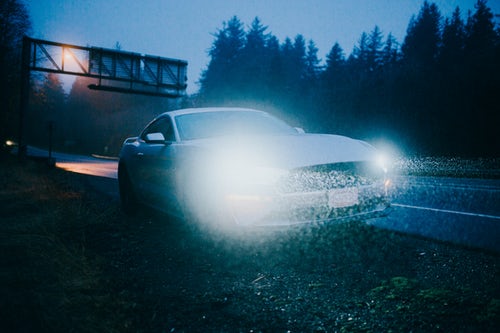A READER NOTICED how often he was flashed by oncoming traffic to warn him about a speed trap ahead, and asked us about the appropriateness of such behaviour.
It’s a great question and comes down to two issues: legality and morality.
Is it legal?
Legally, the situation is quite clear: it is legal to warn an oncoming motorist of a speed trap. But, surprise, surprise, it’s not quite as simple as that.
When most motorists flash headlights to warn oncoming motorists of a speed trap, they will use the simplest method – pulling back the high beam wand and that, technically, is an offence, not because it is illegal to warn a motorist but because a driver of a vehicle must not use the vehicle’s headlights on high beam if the driver is less than 200 metres behind a vehicle travelling in the same direction, or less than 200 metres from an oncoming vehicle (Australian Road Rules (2006) Section 218).
By definition, flashing your headlights using low beam only is legal. The high beam flash isn’t.
Not unexpectedly, police take a dim view of motorists warning other motorists of a speed trap, and use the high beam rule to exact revenge.
It’s a worldwide phenomenon. In the UK in 2012, Lancashire police issued 20 tickets for “misuse of headlights” when they apprehended motorists warning other motorists of a speed trap. Reason? “Flashing your headlights at someone may make them slow down for a second, but it will not make them change their habits. Speeding motorists need to be spoken to so they will seriously consider their irresponsible driving.” Okay, but how does that relate to fixed speed cameras. And cameras on mobile police vehicles? Pinged motorists don’t learn until the penalty notice arrives, often weeks later.

There’s another issue, highlighted by a court case (again, in the UK). Drivers were found not to be breaking the law by flashing oncoming drivers unless police could prove that the cars being flashed were actually speeding. The court decision was arrived at because drivers could only be fined if it could be proved they were “aiding and abetting someone to get away with a crime” (i.e. speeding) and “interfering with the police in the course of their duties”. A certain Charles Glendinning was initially convicted of “wilfully obstructing police” when warning oncoming drivers of a speed trap on the A303. On appeal, the charges were dismissed.
In 2014, traffic superintendent Dean McWhirter of the Victorian Police said he was happy for motorists to flash their lights to warn other motorists they were approaching a speed camera. “If that occurs, I am comfortable with it because it means people are getting the message,” he said. Presumably, if they only use low beam.
In the US, meanwhile, there is a wider issue. The right to warn motorists of a speed trap is, apparently, enshrined in the Constitution under the First Amendment.
A Texas woman spent 12 hours in the county jail. She was trying to warn motorists of a speed trap and charged with the misdemeanour of (and you are going to love this) “standing in the street where a sidewalk is present”. The Houston resident was riding her bicycle home when she noticed the police speed trap. She stopped her bike and used a grocery bag to write a sign warning drivers of the impending speed trap. When police noticed what she was doing, they arrested her. Australia has no laws protecting freedom of speech.
In the early days of motoring, the UK AA instructed patrol men to salute any vehicle wearing an AA badge. If a patrolman failed to salute an AA member, it was a clear indication that there was a speed trap ahead. Authorities thought this was unreasonable and took the AA to court to discourage the practice.

But back to local jurisdiction. In NSW there is no specific rule that states you are not allowed to flash your headlights to warn other road users that the police are ahead. In fact, most police will appreciate you warning other motorists that they are doing their job. However, legal advice is that you could, conceivably, be issued with an infringement notice if the police officer were to allege that while warning the other driver, you were also likely to dazzle them. We mentioned earlier the Australian Road Rule, but there is a local NSW road rule (219) that make it an offence to use, or allow to be used, any light fitted to or in the driver’s vehicle to dazzle, or in a way that is likely to dazzle another road user.
Another consideration must be the regular reporting of the locations of speed traps by radio stations and newspapers. If the law doesn’t consider their actions interfering with police operations, how can a private motorist warning oncoming drivers be treated differently?
Is it morally defensible?
Okay, so we’ve established that, technically, it is legal to warn oncoming drivers about a speed trap, but is it morally justifiable?
Naturally, each driver’s interpretation will vary, and ultimately the decision comes down to the individual.
Personally, I will warn oncoming drivers if I feel that the speed trap has been set in a position that is more aimed at generating revenue than in the interests of safety. Despite assurances that speed traps would not be set at the bottom of hills or soon after a change of speed limit, they continue to be located in these lucrative zones.
I will also warn oncoming drivers if the speed trap is a private or franchised operation (i.e. not operated by police). Usually these can be identified as an anonymous grey Camry with extreme window tint parked on the side of the road. These almost always seem to be positioned to capture as many unsuspecting motorists as possible, even when the road and conditions are not dangerous at speeds a little above the speed limit.

And, most importantly, I only flash the headlights using the light switch, not the high beam wand (although whether a police officer or court would accept my defence that I wasn’t using high beam would come down to my word against theirs).
On the other hand, if I see a vehicle coming towards me travelling at well above the prevailing speed limit, that driver has made a conscious decision to ignore the speed limit. He or she deserves to be penalised, and hopefully will learn from the experience and slow down in future (although getting an infringement notice in the mail weeks after the offence is not the most efficient deterrent).
Many drivers are of the opinion that speeding motorists “deserve to be penalised” and therefore will not warn them of a speed trap. This is a reasonable assertion, although it ignores the reality that almost every driver speeds at some point, even if unintentionally. As a motoring writer colleague has pointed out to me, the only “safe” place to speed is where it’s not safe, by which he means speed traps are almost always set up on stretches of road where it’s safe to do so, and almost never set up on stretches of road where speeding is dangerous (because the hit rate on such stretches of road will make it economically unviable). This is why they are so often set up on straight roads with good visibility, on overtaking lanes where frustrated motorists are forced to exceed the speed limit to overtake vehicles that previously had been travelling under the limit, and on stretches of road immediately after a long downhill gradient and usually just after a change of speed limit.
So, morally defensible? This one we have to leave to your own judgement.
Have you been cautioned or fined for warning other drivers about a speed trap? Do you agree or disagree that warning other motorists is legitimate, or is it thwarting the police and authorities in their attempts to discourage speeding? We’d love to hear from you.
